The Durian Stall
Source: Permission
granted by and written by Yow
Siew Kah
I
observe that contemporary artists in Singapore do not refer to the works of
past Singaporean artists in their art-making activities. The younger artists
seek inspiration from many sources, including European art history, contemporary
practices of artists from other Southeast Asian countries, current issues
in the Singapore political scene, and so on. However, it is hard to find an
artist who admits to creating works which seriously refer to the practices
of artists who are part of Singapore art history.
In this article, I look at two works by Singapore based artists which were
created forty-four years apart. Although these works were executed independently,
they are similar in many ways. In making the works, both artists searched
for places which they considered representative of their local surroundings.
Both artists decided on the durian stall, which symbolises not modernity but
tradition. The artists' choice of a traditional scene over a modern one was
related to their search for a way to represent their identities, a concern
that is as important among Singaporean artists today as it was a generation
ago.
In discussing the relationship between these two works, I wish to show that:
although the physical landscape of Singapore has changed considerably since
the 1950s, artists today still ask some of the same questions asked by those
who practised art many years ago in the same geographical space. Contemporary
art practitioners may find it interesting to see how artists from past generations
attempted to answer these questions.
The Two Images
The two works I will discuss are: Liu Kang's (1911-2004) 'Durian Vendors'
(1957) and Lee Sze-Chin's (b.1979) 'Touring Natives #1' (2001). Both of the
works use an image of a durian stall as a representation of local culture.
Although the durian stall is part of the modern Singapore landscape, as much
in the 1950s as it is now, it is not a symbol of modern Singapore. Unlike,
say, a tall commercial building. Rather, a durian stall represents the primitive
side of Singapore culture, the facet that is considered unchanging, close
to nature, and essential. Why did the artists choose to represent Singapore
as primitive? I will look at the images in turn.
Liu Kang’s 'Durian Vendors'
Liu Kang, who is an important figure in Singapore art history, is well known
for his drawings and paintings of Southeast Asian subjects. Born in Malaya,
Liu went to China in the 1920s to study art. Like many Chinese artists of
his generation who practised Western style painting, he went on to France
to learn more about French modernism. Under the influence of Chinese artist
and art teacher Liu Haisu, Liu Kang admired, and often appropriated the styles
of French-based modernist painters such as Cézanne, van Gogh and Matisse.
I have observed that Liu's works resemble those of the French painters in
the way he primitivised his subjects. Like Matisse and his Oriental subjects,
Liu painted his Malayans as "primitives", depicting them in native
settings which are considered essential to their cultures. For example,
Liu often represented Malay people in their traditional clothes and kampong
houses, unlike the works of some of his contemporaries which show Malays in
Western clothes. It is tempting to say that Liu Kang painted his Malayans
as inferior "others" because he was influenced by the French masters.
However, this is too simplistic an explanation. While Matisse's way of painting
can be explained by the formalised power relationship he had as a European
man with an Oriental woman in a French colony, Liu's primitivising tendencies,
which are exhibited in the way he painted his own surroundings, cannot
be explained similarly. So why did Liu Kang choose to represent his own environment
as primitive?
I would like to suggest that Liu Kang's primitivising tendency has its roots
in the Chinese modern art movements during the Republic era (1911-1949). During
this period, Chinese intellectuals exhibited a certain patriotic concern with
the well being of China, believing that Chinese culture was in decline and
it was necessary to introduce new ideas, particularly those from Europe and
North America, into China in order to cure the country of its ailments.[1]
In examining their own culture, these intellectuals distanced themselves from
China and looked at it from the outside, as though their own culture was a
foreign one.[2] At the same time when
the Chinese were looking at themselves, they were also being looked at by
the metropolitan centre. The two ways of looking interacted in such a way
that the gaze of the metropolitan centre was built into the way the Chinese
saw themselves, which led to the Chinese intellectuals creating representations
of Chinese people as though such representations were to be viewed by the
centre.[3] The primitive element in
the cultural production in this period is therefore a direct result of the
intellectuals attempting to find answers to questions like "What is wrong
with Chinese culture?" and "What can we do to rescue the Chinese
people from falling further?"– questions which were about Chinese
identity.
Liu Kang, under the influence of these May Fourth intellectuals, developed
a similar obsession with examining his own culture, which continued to be
manifested in his works after he moved to Malaya permanently in the 1930s.
The primitive element in many of his works was directly related to the self-conscious
way in which he sought to represent his local surroundings.
 |
|
Liu
Kang, 'Durian Vendors' (1957)
Liu Kang Family Collection at Singapore Art Museum |
'Durian Vendors' (whose original Chinese title 'mai liu lian', translated
literally as 'Selling Durian', describes the image more accurately) shows
five men taking part in the durian trade: the man in the centre, who is a
vendor, holds a balance in his hands, weighing an unseen fruit. The men to
his left and right are shown performing the important acts of appraising the
quality of the durians: bringing the fruit close to the face for a good sniff,
prying open the fruit and putting a pulpy seed in his mouth to assess, and
possibly to savour the taste. In the foreground, Liu painted a pile of purple
mangosteens, a fruit that is usually sold in durian stalls because its tastes
and medicinal properties are considered complementary to those of the durian.
This image, partly from a lack of background details, appears to be suspended
in time and space. Like an Orientalist painting by Delacroix or Gérôme,
there is no sense of history in the image.[4]
It is as though Liu painted a world without change. At the same time, the
painting, while not being a "realistic" representation of what Liu
Kang saw on the streets of Malaya, is calculated and deliberate – it
is "correct". The painting looks like an illustration on how to
eat durian, to be studied carefully by someone who is not familiar with such
an activity as a kind of instructional diagram. Such deliberateness can be
seen in other paintings from the same period, such as 'Indian Festival' (1957)
and 'Happy Village' (1956). These paintings, taken together, can serve as
a series of images for educating a person who is new to Malaya on life in
the area. These images could only have been produced if Liu saw himself to
be outside of what he represented, a way of seeing that carried the gaze of
the metropolitan centre.
Lee Sze-Chin's 'Touring Natives #1'
 |
|
Lee
Sze-Chin, 'Touring Natives #1' (2001)
Collection of the artist |
A
similar sense of self-consciousness underlies the production of Lee Sze-Chin's
'Touring Natives #1'. Lee says that this work is part of a series which involves
his taking photographs obsessively of places, activities and objects which
he considered essential in the construction of a Singapore identity.[5]
Many of Lee's images from this series are of things that are disappearing
from Singapore. This means that Lee's subjects are tied to the past –
a "primitive" time period. Like Liu Kang, Lee was concerned with
creating images of his local surroundings. As someone who shares with Liu
a similar obsession with examining and making visual representations of his
own culture, Lee's image (like Liu Kang's) have a "to-be-looked-at-ness"
that is a result of the presence of the gaze of the metropolitan centre in
the way he looks. It is therefore not coincidental that both Liu and Lee chose
the durian stall as an image that represents Singapore.
However,
there is a key difference in the way the two artists represented the local.
While Liu painted the durian vendors as "others", Lee made himself
part of the local by putting himself in the image. That image, while clothed
in attire that identifies him as a tourist, is not presented as superior to
the other people in the photograph. Although Lee may look at Singapore culture
from the outside (he admits to having developed the interest to examine his
own identity after returning from his art education in London)[6],
by inserting his own image in a representation of Singapore culture, he avoids
depicting those around him as "exotic others", but makes himself
part of what he examines. Unlike Liu Kang who wished to be seen apart from
the durian vendors, Lee identified himself as an object of the gaze of the
centre.
Conclusions
The question of identity is one that continuously informs the works of artists
practising outside of the metropolitan centre. Singaporeans, being at the
periphery, look at themselves in a way that is always related to how we are
looked at by the centre. Analyses of images of Singapore made by Singaporeans
(both historical and contemporary) should take into account the complex interaction
between these two ways of looking.
Acknowledgements
My sincerely thanks to:
Lee Sze-Chin for sharing freely information on his works in the many conversations
we had in the past month. I would also like to acknowledge his kindness in
providing me with a copy of 'Touring Natives #1' for this essay.
Patric Ong of Singapore Art Museum in granting me permission to use Liu Kang's
'Durian Vendors' in this article.
Tiw Lee Peng and Nor Jumaiyah, both of Singapore Art Museum, for reproducing
and sending me an copy of Liu Kang's 'Durian Vendors'.
About the Artist
Lee Sze-Chin is an artist and art educator. He received a Bachelor's degree
in Fine Arts from Goldsmith's College, London and is current enrolled in the
Postgraduate Diploma in Education program at the National Institute of Education,
Nanyang Technological University, Singapore.
References
(1) Rey Chow, Primitive Passions: Visuality, Sexuality, Ethnography, and
Contemporary Chinese Cinema (New York and Chichester, West Sussex: Columbia
University Press, 1995), 4-52. Chow observes that Chinese writers and film
makers produced works that primitivised Chinese subjects. She relates this
to the idea of 'Obsession with China' proposed by sinologist C. T. Hsia. See
C. T Hsia, 'Obsession With China: The Moral Burden of Modern Chinese Literature,'
in A History of Modern Chinese Fiction, 2nd ed. (New Haven and London:
Yale University Press, 1971), 533-609.
(2)
Chow, 19.
(3)
Chow, 180. Chow explains that the Chinese were
the object of the European gaze. This gaze is incorporated into the gaze of
the Chinese intellectuals when examined their own culture, so that while they
are doing the looking, they are also being looked at. Chow calls this the
"optical unconscious" of the Chinese intellectuals'
(4) Art historian Linda Nochlin made
this observation. See Linda Nochlin, 'The Imaginary Orient,' in The Politics
of Vision: Essays on Nineteenth-Century Art and Society (London: Thames
and Hudson, 1991), 35-36.
(5)
Conversation with the artist.
(6)
Conversation with the artist.
Yow Siew Kah is a Ph.D. candidate in visual arts at the National Institute of Education, Nanyang Technological University, Singapore, at the point of writing this article.